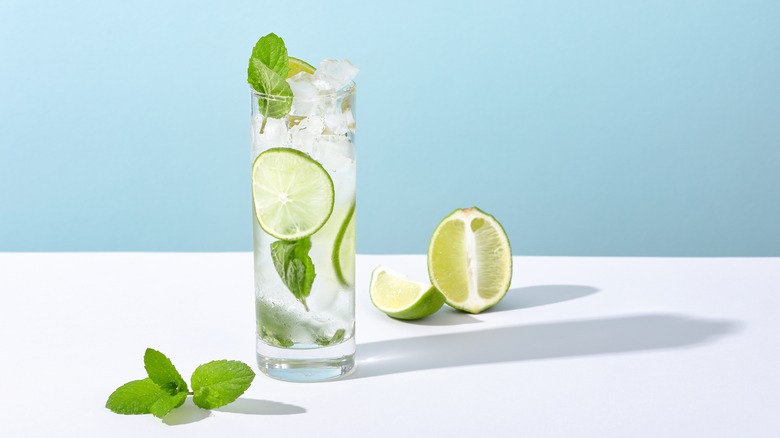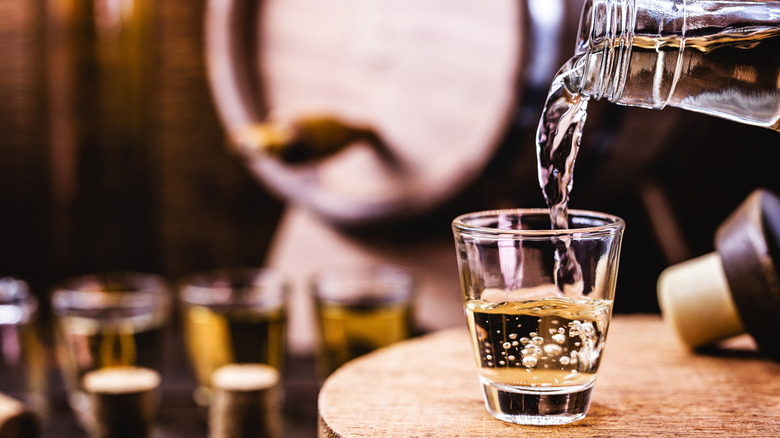Light Rum Is The Best Alcohol To Use For Your Mojito
Nothing screams summer quite like a mojito. The classic Cuban cocktail is the perfect thirst quencher for warm weather days spent lounging by the pool or grilling with friends, though it is possible to add fall flavors as the seasons change (try an apple cider mojito on a crisp autumn evening).
Containing just a few simple ingredients — lime juice, mint leaves, sugar, club soda, and rum — the mojito is a refreshing crowd-pleaser. It can easily be customized to fit any taste preference, but the most basic versions usually have one thing in common: light rum. Even the mojito's forebear (called the Draque), which predates rum's invention and was named after Sir Francis Drake, featured an unaged, colorless cane distillate called aguardiente de caña.
While dark rums may add depth and complexity to other cocktails like mai tais and Jungle Birds, light rum — also called white or silver rum — is the best booze to use for a mojito. Its clean and subtle flavor profile allows the brightness of the drink's other ingredients to shine through. However, there's more to it than just choosing any old light rum. Some white rums are unaged, exhibiting a pronounced grassiness. Others are minimally aged and then filtered to produce a clear spirit that still carries some of the nuances of the maturation process.
When it comes to rum, age is more than just a number
A sweet and heady liquor, rum has roots that date back to the 17th century when plantations in the Caribbean began producing the spirit after discovering that molasses, a byproduct of sugarcane production, could be fermented and distilled.
Heavier, full-bodied rums were the first to circulate throughout the West Indies and beyond, hailing from places like Barbados and Jamaica. It wasn't until later in the 19th century that rum producers in places like Puerto Rico and Cuba began to play with fermentation, adding cultured yeasts to yield light rum's mild and smooth-tasting profile.
Dark rums are aged for at least five to seven years in charred oak barrels, giving them caramel, vanilla, and spice notes. Light rums are produced in modernized column stills (as opposed to traditional pot stills) and can age in barrels or steel tanks for between one and four years, yet because of filtration, they often lack the noticeably rich, oaky taste of darker varieties. This simplicity is what makes light rum ideal for mixing in mojitos.
The blending and aging process significantly influences each rum's eventual color and overall flavor profile. Choosing the best one for your mojito, therefore, means you'll want to consider these factors as well as where and how the rum was produced.
Why is light rum the best for mojitos?
Knowing the differences between rums, it's easy to see why the less-aged stuff is preferred for a great mojito. Its smoothness perfectly complements the drink's sweet, sour, and minty components to create a cocktail that is refreshing and zesty. The intensity of some dark rums, on the other hand, can compete with the rest of the ingredients.
As such, most standard mojito recipes call for white rum. While making the drink using aged rum isn't frowned upon, the darker aged rums are probably best saved for sipping neat, mixing with strong ginger beer, or making rum balls. Their complexities are best appreciated either solo or with similarly rich flavors.
The key to making an excellent mojito is to use high-quality light rum that brings out the drink's other flavors without overpowering them. Want to add a touch of culture and history to this timeless Cuban cocktail? Opt for light Cuban rum, which differs from other Caribbean rums due to its gentler flavor profile (the result of an old request from the Spanish Crown that produced a lighter, softer spirit that rum lovers worldwide still enjoy today). Or get creative and jazz up a regular mojito with tart fruits like hibiscus and blackberry.


